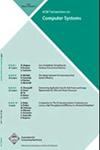使用原始VMware工作站将虚拟化带入x86架构
IF 1.8
4区 计算机科学
Q2 COMPUTER SCIENCE, THEORY & METHODS
引用次数: 100
摘要
本文描述了VMware Workstation在1999年将虚拟化引入x86架构时所使用的历史背景、技术挑战和主要实现技术。尽管虚拟机监视器(vmm)已经存在了几十年,但它们传统上被设计为单一供应商架构的一部分,并明确支持虚拟化。相比之下,x86架构缺乏虚拟化支持,围绕它的行业已经分解成一个生态系统,由不同的供应商控制计算机、cpu、外围设备、操作系统和应用程序,没有一个供应商要求虚拟化。我们选择独立于这些供应商构建我们的解决方案。因此,VMware Workstation必须应对以下方面的新挑战:(1)x86架构中缺乏虚拟化支持,(2)架构本身令人生畏的复杂性,(3)需要支持广泛的外设组合,(4)需要在现有环境中提供简单的用户体验。这些新的挑战促使我们将知名的虚拟化技术、来自其他领域的技术和新技术结合起来。VMware工作站结合了托管架构和VMM。托管架构支持简单的用户体验,并提供广泛的硬件兼容性。VMware Workstation还依赖于I/O设备的软件仿真,而不是将I/O多样性暴露给虚拟机。VMM将捕获和模拟直接执行引擎与系统级动态二进制转换器相结合,以有效地虚拟化x86架构并支持大多数商用操作系统。通过依赖x86硬件分段作为保护机制,二进制转换器可以以接近硬件的速度执行翻译后的代码。二进制翻译器还依赖于部分求值和自适应重新翻译来减少虚拟化的总体开销。本文将分享我们从构建原始系统及其后来的演变中学到的关键经验教训。本文章由计算机程序翻译,如有差异,请以英文原文为准。
Bringing Virtualization to the x86 Architecture with the Original VMware Workstation
This article describes the historical context, technical challenges, and main implementation techniques used by VMware Workstation to bring virtualization to the x86 architecture in 1999. Although virtual machine monitors (VMMs) had been around for decades, they were traditionally designed as part of monolithic, single-vendor architectures with explicit support for virtualization. In contrast, the x86 architecture lacked virtualization support, and the industry around it had disaggregated into an ecosystem, with different vendors controlling the computers, CPUs, peripherals, operating systems, and applications, none of them asking for virtualization. We chose to build our solution independently of these vendors.
As a result, VMware Workstation had to deal with new challenges associated with (i) the lack of virtualization support in the x86 architecture, (ii) the daunting complexity of the architecture itself, (iii) the need to support a broad combination of peripherals, and (iv) the need to offer a simple user experience within existing environments. These new challenges led us to a novel combination of well-known virtualization techniques, techniques from other domains, and new techniques.
VMware Workstation combined a hosted architecture with a VMM. The hosted architecture enabled a simple user experience and offered broad hardware compatibility. Rather than exposing I/O diversity to the virtual machines, VMware Workstation also relied on software emulation of I/O devices. The VMM combined a trap-and-emulate direct execution engine with a system-level dynamic binary translator to efficiently virtualize the x86 architecture and support most commodity operating systems. By relying on x86 hardware segmentation as a protection mechanism, the binary translator could execute translated code at near hardware speeds. The binary translator also relied on partial evaluation and adaptive retranslation to reduce the overall overheads of virtualization.
Written with the benefit of hindsight, this article shares the key lessons we learned from building the original system and from its later evolution.
求助全文
通过发布文献求助,成功后即可免费获取论文全文。
去求助
来源期刊

ACM Transactions on Computer Systems
工程技术-计算机:理论方法
CiteScore
4.00
自引率
0.00%
发文量
7
审稿时长
1 months
期刊介绍:
ACM Transactions on Computer Systems (TOCS) presents research and development results on the design, implementation, analysis, evaluation, and use of computer systems and systems software. The term "computer systems" is interpreted broadly and includes operating systems, systems architecture and hardware, distributed systems, optimizing compilers, and the interaction between systems and computer networks. Articles appearing in TOCS will tend either to present new techniques and concepts, or to report on experiences and experiments with actual systems. Insights useful to system designers, builders, and users will be emphasized.
TOCS publishes research and technical papers, both short and long. It includes technical correspondence to permit commentary on technical topics and on previously published papers.
 求助内容:
求助内容: 应助结果提醒方式:
应助结果提醒方式:


